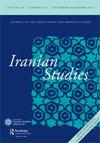IF 0.9
4区 社会学
Q2 AREA STUDIES
引用次数: 0
摘要
本文是对Ali Akbar Tashakori用波斯语写的三卷本关于中世纪和现代雅兹迪琐罗亚斯德教社会史的评论文章这项工作超越了雅兹迪社区的历史,涵盖了更广泛的伊朗琐罗亚斯德教的历史。尽管有一些新奇之处,但这些卷主要依赖于对公元第二个千年伊朗琐罗亚斯德教历史的传统重建。这一重建的基本要素包括伊朗的逐渐伊斯兰化和随后琐罗亚斯德教徒“撤退”到亚兹德和克尔曼的“边缘”地区,琐罗亚斯德教徒在中世纪和近代早期面临的挑战性条件,19世纪伊朗琐罗亚斯德教徒在帕西人的帮助下开始的社会和知识“解放”,该社区在卡扎尔晚期和巴列维早期的政治和经济影响日益增加,以及巴列维家族在提升琐罗亚斯德教在更广泛的伊朗社会中的地位方面所起的特殊作用。Tashakori对这些叙述的广泛依赖,不仅为他提供了一个回顾自己的新解释的机会,也为重新评估这些长期存在的假设提供了机会。此外,文章强调了与雅兹迪社区有关的被忽视的主要来源。本文章由计算机程序翻译,如有差异,请以英文原文为准。
Yazd and its Zoroastrians
Abstract This is a review article of a three-volume book in Persian by Ali Akbar Tashakori on the social history of Yazdi Zoroastrians in medieval and modern times.1 The work goes beyond the history of the Yazdi community, encompassing the broader history of Iranian Zoroastrians. Despite certain novelties, the volumes largely rely on a conventional reconstruction of the history of Iranian Zoroastrians in the second millennium CE. The foundational elements of this reconstruction include the gradual Islamization of Iran and the subsequent “retreat” of Zoroastrians to the “marginal” regions of Yazd and Kerman, the challenging conditions faced by Zoroastrians in medieval and early modern times, the beginning of Iranian Zoroastrians’ social and intellectual “emancipation” in the nineteenth century with Parsi assistance, the community's increasing political and economic influence in the late Qajar and early Pahlavi eras, and the Pahlavis’ exceptional role in elevating the status of Zoroastrians within wider Iranian society. Tashakori's extensive reliance on these narratives offers an opportunity to not only review his own new interpretations, but also to reassess these long-standing assumptions. Additionally, the article highlights neglected primary sources pertaining to the Yazdi community.
求助全文
通过发布文献求助,成功后即可免费获取论文全文。
去求助
来源期刊

Iranian Studies
Multiple-
自引率
0.00%
发文量
92
期刊介绍:
Iranian Studies is a peer-reviewed journal devoted to Iranian and Persian history, literature, and society, published on behalf of the Association for Iranian Studies . Its scope includes all areas of the world with a Persian or Iranian legacy, especially Iran, Afghanistan, Central Asia and the Caucasus, and northern India, and Iranians in the diaspora. It welcomes submissions in all disciplines.
 求助内容:
求助内容: 应助结果提醒方式:
应助结果提醒方式:


